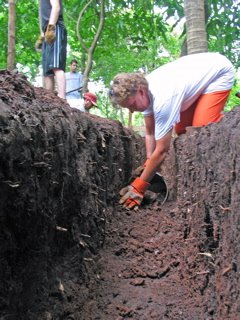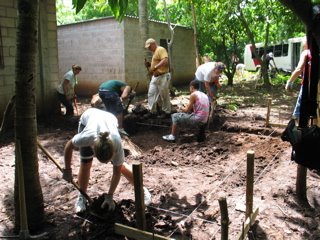Lorna's Reflections on the People of Puente Azul
It was Monday. We had been in El Salvador since Thursday just hanging out, learning about the culture and just being well tourists. But now it was time to start what we came here to do, work. None of us knew where we were going or what exactly we would be doing. When we got there we were all filled with a mix of excitement and nervousness. When the hot bus finally came to a stop we all sat up and looked out the windows, only to see the worst poverty that anyone had ever experienced. As we stepped off the bus and into the hot humid air we were greeted by a group of kids (most of which weren’t fully dressed). None of us new what to say we just kind of stood there. Marco went up to one of the men and started talking to him. He was an older gentleman but was obviously the one who would be guiding us. We had brought bags of toys for the children but weren’t really sure at first how to give them or even introduce ourselves to them. We decided to just get them out and see how it went from there. Chris with the crayons, jacks and a matching game successfully attracted and occupied the younger kids. I decided that since Uno was such a big hit at the Synod that it couldn’t go wrong here. Me and about 5 other older children sat down. Using my newly learned Spanish numbers I tried really hard to explain it. But the language barrier got in the way yet again. They were looking at me like I was dumb, yes me dumb, I know it’s hard to believe but they were. I passed out the cards and they had no idea what to do. I realized that maybe a ball would be a better idea, and it was. I don’t remember exactly when the little wide-eyed, smiling girl, named Christina took my hand and led me inside the church. They had set up the plastic chairs in a circle. Christina was so desperately trying to tell me they wanted me to play duck, duck, goose. Finally I understood that Pato, Pato, Gonzo meant duck, duck, goose. So I sat down not really knowing how this was going to work, but before I knew it, I was running around the circle trying not to step on Nappo and catch them! The little boy who had picked me...this was fun...finally a game we can play. It was probably the 20th time I had run around the circle, I was soaked with sweat and tired, that I realized that I hated pato, pato, gonzo. Then I saw their little smiles, I mean everybody was laughing and screaming in joy. I knew I couldn’t go take a water break by the bus or even work outside for a little bit because that moment was way too precious. Who would have thought that I would go to El Salvador to play Pato, Pato, and Gonzo? IT was at the end of our stay, Friday. We had bought these two HUGE piñata’s one chicken little and the other was a yellow dinosaur. We stuffed them with the McDonalds toys that my little sisters still have noticed were missing, and candy. There were a ton of kids all gathered around, but before we could have fun and let them play with them we had a worship service to attend. The small concrete church was packed! (most of them being children) After the almost blind man sang, the preacher talked for a little while, and I struggled through the presentation of the gifts we had bought for pastor Luis (a bed, portable shower, pillows, blankets and a few lanterns). It was time to line the many kinds up so they could hit the piñatas. It was a huge success, as soon as the piñata broke it was like seagulls on a piece of bread. I was crazy. For the second piñata Dale broke it. And again it was a frenzy. It was finally time to leave. As we all said our tearful goodbyes to the children and the people of Puente Azul and made sure that everybody was on the bus we pulled away from the village. All of the children were waving as we left. While we were sitting on the bus I think that we all felt an overwhelming feeling of satisfaction and sadness. We watched the sudden poverty change back into the city as the bus rocked over the terrible roads. We were finally going home probably never to return again. Or were we? Was this goodbye forever? Probably not, definitely not?! Maybe we should have been saying see ya later.



